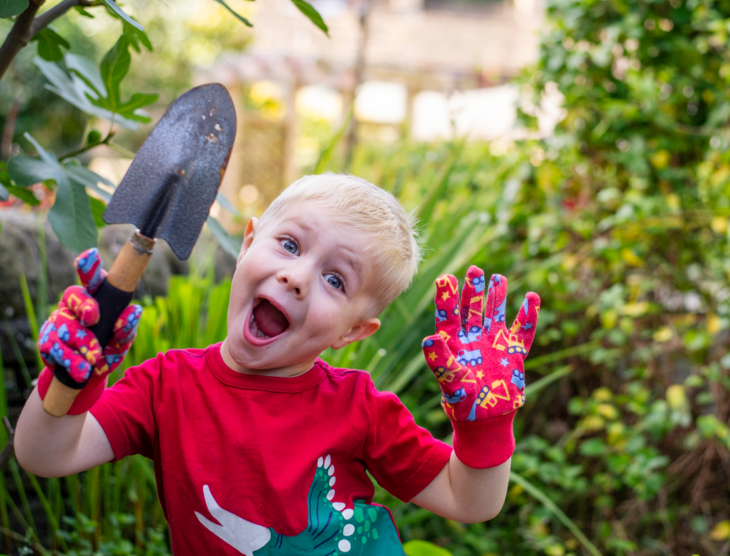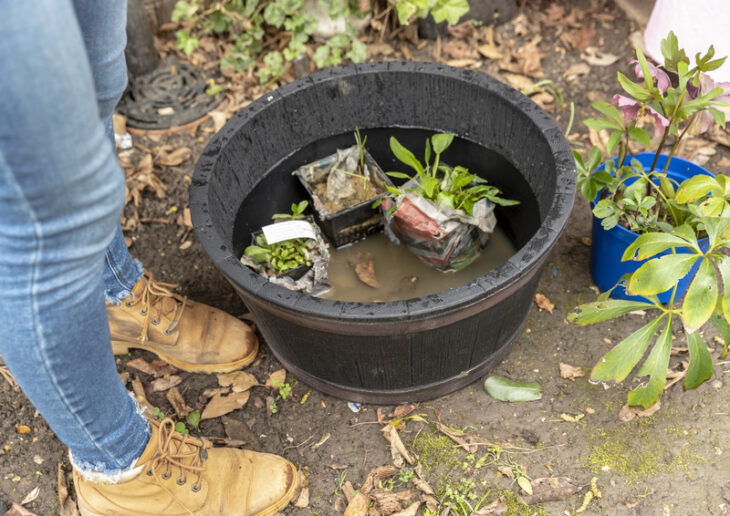In the last century, more than half of all ponds in the UK countryside have been lost. Looking to help wildlife in your local space? Install a wildlife pond!
You’ll be amazed how much wildlife even a small pond can support, from insects to amphibians, plants to birds – almost all garden life and every part of the food chain will benefit from a water source.
Ponds can be as big or small as you like, even an upturned dustbin lid sunk into the ground and filled with water will soon be a hive of activity!

If you don’t have a garden, you could contact the owner of a local green space to see if they would be interested in installing a wildlife pond with you. You can build a pond at any time of the year, but if you start in late winter, it will get established much quicker.

EXTRA: Download the pond wildlife spotter sheet below to help you identify some creatures that might visit your mini pond!
What you will need:
- An old bucket or watertight container
- A spade
- Sand
- Old bricks, rocks or pebbles
- Native pondweed or other pond plants
How to build your mini wildlife pond:
- Choose an ideal spot. Your pond will want light, but not full sunlight all day. Dig a hole deep enough to sink your container (unless you choose to place your container above ground).
- Remove any sharp rocks and line the bottom of the hole with sand.
- Place the bucket into the hole, filling in any gaps around the edges with soil.
- Add a layer of bricks or rocks. Use logs or stones to create a range of depths and a slope for creatures to climb in and out. If your container is above ground, you’ll need to create a ramp.
- Fill the bucket with rainwater (not tap water – this contains chemicals).
- Start adding some pond plants! You only need one or two plants. Great plants for small ponds include miniature waterlily, lesser spearwort, starwort, and flowering rush.
- Over the next few weeks, check your pond regularly to see if it needs topping up. Sit and watch as wildlife comes to your pond (you can use the pond life spotter sheet). Don’t introduce frogs, fish or even water from another pond as this can spread disease.
Pond plant tips:
There are four ‘zones’ in which pond plants may be grown and it’s best to try to have plants in each zone.
Floating-leaved plants
Floating-leaved plants are good places for the eggs of pond snails, dragonflies and newts. Species include amphibious bistort, bladderwort, frogbit, curled pondweed and water crowfoot.
Submerged aquatic plants
Submerged aquatic plants oxygenate the water and provide cover for pondlife. Species include water starwort, hornwort, horned pondweed and spiked water-milfoil.
Emergent plants
Emergent plants will send their leaves and flowers up above the water’s surface. Species include flowering rush, bog bean, arrowhead and water mint.
Marginal plants
Marginal plants will grow happily around the edge of your pond. Species include water forget-me-knot, yellow iris, marsh marigold, meadowsweet and water pepper.
Share photos of your pond creation with us by using #DiscoverLearnPlay
